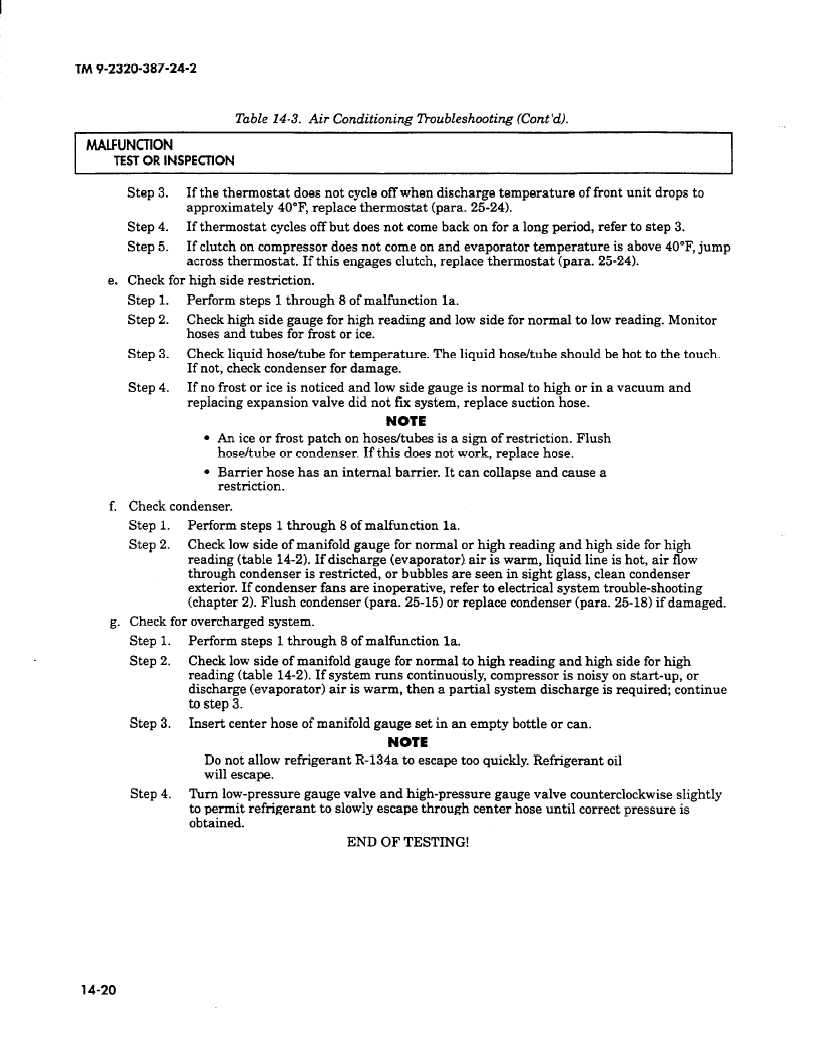TM 9-2320-387-24-2
Table 14-3. Air Conditioning Troubleshooting (Cont’d).
MALFUNCTION
TEST OR INSPECTION
Step 3.
If the thermostat does not cycle off when discharge temperature of front unit drops to
approximately 4O”F, replace thermostat (para. 25-24).
Step 4.
If thermostat cycles off but does not come back on for a long period, refer to step 3.
Step 5.
If clutch on compressor does not come on and evaporator temperature is above 4O”F, jump
across thermostat. If this engages clutch, replace thermostat (para. 25-24).
e. Check for high side restriction.
Step 1.
Perform steps 1 through 8 of malfunction la.
Step 2.
Check high side gauge for high reading and low side for normal to low reading. Monitor
hoses and tubes for frost or ice.
Step 3.
Check liquid hose/tube for temperature. The liquid hose/tube should be hot to the touch.
If not, check condenser for damage.
Step 4.
If no frost or ice is noticed and low side gauge is normal to high or in a vacuum and
replacing expansion valve did not fix system, replace suction hose.
NOTE
l An ice or frost patch on hoses/tubes is a sign of restriction. Flush
hose/tube or condenser. If this does not work, replace hose.
l Barrier hose has an internal barrier. It can collapse and cause a
restriction.
f. Check condenser.
Step 1. Perform steps 1 through 8 of malfunction la.
Step 2.
Check low side of manifold gauge for normal or high reading and high side for high
reading (table 14-2). If discharge (evaporator). air is warm, liquid line is hot, air flow
through condenser is restricted, or bubbles are seen in sight glass, clean condenser
exterior. If condenser fans are inoperative, refer to electrical system trouble-shooting
(chapter 2). Flush condenser (para. 25-15) or replace condenser (para. 25-18) if damaged.
g. Check for overcharged system.
Step 1.
Step 2.
Step 3.
Step 4.
Perform steps 1 through 8 of malfunction la.
Check low side of manifold gauge for normal .to high reading and high side for high
reading (table 14-2). If system runs continuously, compressor is noisy on start-up, or
discharge (evaporator) air is warm, then a partial system discharge is required; continue
to step 3.
Insert center hose of manifold gauge set in an empty bottle or can.
NOTE
Do not allow refrigerant R-134a to escape too quickly. Refrigerant oil
will escape.
Turn low-pressure gauge valve and high-pressure gauge valve counterclockwise slightly
to permit refrigerant to slowly escape through center hose until correct pressure is
obtained.
END OF TESTING!
14-20

